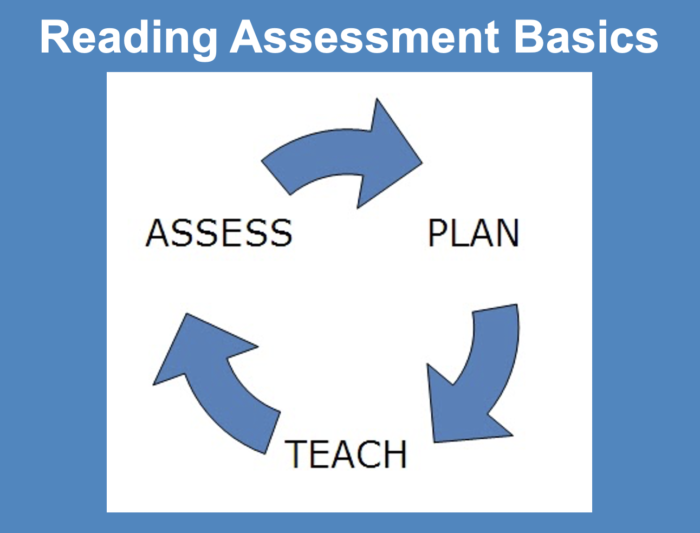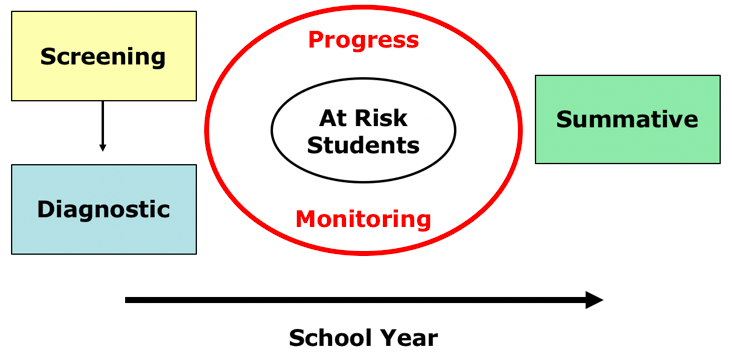

Reading assessment is essential for supporting effective reading instruction. Reading assessment data provides teachers important information to guide instructional decisions. It also helps guide school leadership as they make reading curriculum decisions. The Institute of Education Sciences (IES) practice guide Using Student Achievement Data to Support Instructional Decision Making (Hamilton et al., 2009) highlights the value of assessment data: “Using data systematically to ask questions and obtain insight about student progress is a logical way to monitor continuous improvement and tailor instruction to the needs of each student. Armed with data and the means to harness the information data can provide, educators can make instructional changes aimed at improving student achievement, such as:
This goal of this blog post is to share basic explanations of key terms related to reading assessments. The text and graphics are from from Module 11 of the Keys to Beginning Reading professional development online course (Sedita, 2019).
Assessment Reliability and Validity
Reliability
Reliability refers to how consistently a test provides dependable, consistent measurement of a skill or ability. If a test is reliable, the same result should be achieved regardless of who administers the test. Personal judgment to determine a score should not be part of the process. Related Essential question: Are the test scores reliable between test administrators? Testing contexts? Test forms?
Validity
A test is valid if it measures the skill or ability it says it is measuring. The results from a valid test are used to make useful, accurate and beneficial decisions. A test is only valid if it is being used for the purposes for which it was designed. Related Essential question: Are we using the test for the right purpose?
Types of Reading Assessments
There are four main types of reading assessments that are used in schools: Screening, Diagnostic, Progress Monitoring, Summative.
Screening and Benchmark
Screening assessments are typically administered to all students at the beginning, middle and end of the year to identify students who might be at risk for reading difficulty. They provide an initial indication of which students might need extra instruction or intensive interventions if they are to reach grade-level reading standards by the end of the school year. The goal of these assessments is to identify students early before start to fail. Sometimes information from the previous year’s summative assessments can be used as part of the screening process. Screening assessments are not diagnostic – they do not provide detailed information about why a student is struggling.
Progress Monitoring
Progress monitoring assessments are sometimes called formative assessments and are given periodically to determine whether students are making adequate progress. The primary goal of these assessments is to determine if the instructional practices being used are enabling students to make sufficient progress related to the development of reading skills. The focus is on developing student learning. Progress monitoring is especially helpful to make sure that students at risk for reading difficulty are making adequate progress and to identify any students who may be falling behind.
There are two types of progress monitoring tests. Curriculum-embedded tests assess the extent to which students have learned the material taught in the current unit of a reading program. They help the teacher identify which students have mastered the material and whether the class is ready to move on to the next unit in the program. There may not be information about the reliability or validity of these tests, but they are useful because they provide information related to which students have learned what has just been taught (Torgesen, 2006).
The second type of progress monitoring tests measure reading skills (e.g., phonemic awareness, phonics, fluency, vocabulary, comprehension) but are not tied to a reading program. These assessments, based on developmental research, establish benchmarks (performance targets) for the beginning, middle, and end of a school year that predict success at meeting grade-level reading standards (Torgesen, 2006).
General progress monitoring assessments should be given at least three times a year for grades K-3. However, at risk students who are receiving intervention instruction should be progress monitored more frequently to determine if the interventions are successful. They can be given as often as weekly (Torgesen, 2006).
Diagnostic
Diagnostic assessments are used to provide information about individual students who may be having reading difficulty. The results of these assessments help determine the cause of that difficulty, and help teachers plan appropriate supplemental instruction or intensive interventions based on individual student needs. There are many kinds of diagnostic assessments that range from informal reading tasks to formal assessments used for psycho-educational testing. They tend to be lengthy, but provide in-depth, reliable assessment of essential reading skills.
Torgesen (2006) notes that it is important to distinguish between diagnostic tests and diagnostic information. “Diagnostic information is any knowledge about a child’s skills and abilities that is useful in planning instruction. It can come from student work, teacher observations, or other tests, as well as diagnostic tests. Diagnostic tests are one important way to obtain diagnostic information that can help guide interventions for students who are experiencing difficulty learning to read. However, reliable and valid diagnostic information can come from sources other than formal diagnostic tests.” (p. 6)
Diagnostic assessments should be administered only for students who are having difficulty learning to read.
Summative
Summative assessments are sometimes called outcome assessments. The most common are standardized tests that are group administered and used to give school leaders and teachers feedback about the overall effectiveness of their reading curriculum and program. They are typically given at the end of the school year. The focus is on measuring student learning at a given point in time. The results from these assessments help determine if the instruction provided by all the educators in the school is sufficient to help all students achieve grade-level reading standards by the end of each year.
More Assessment Terms
Norm-Referenced
These are formal, standardized assessments that compare a student’s reading skills and ability to other students at the same grade or age level. They are usually not administered more than once in a year.
Criterion-Referenced
These can be formal or informal assessments that compare a student’s reading skills to a set of skills, or criterion, that are identified as needed for mastery. They are often administered before and after instruction to measure growth in a particular skill. They can be administered more than once in year.
Curriculum Based Measurement (CBM)
A Curriculum Based Measurement, often referred to as a CBM, is a criterion-referenced assessment of targeted reading skills. The reading skill measures are tied to skills taught as part of the reading curriculum. CBM assessments can be used for screening and benchmarking purposes, and also for progress monitoring.
CBM assessments are typically given to all students three times during the school year: beginning, middle, and end to determine if students are learning specific reading skills at a growth rate expected for their grade level. When used for this purpose, grade-level assessments are used and student scores are compared to norms based on scores of students at the same grade or age level. Two common examples of CBM subtests for grades K-3 reading foundation skills include the Dynamic Indicators of Basic Early Litearcy Skills (DIBELS) and Acadience Reading. They measure skills such as letter naming fluency, letter-sound fluency, phoneme segmentation fluency, nonsense and whole word reading fluency, and oral reading fluency.
However, CBM assessments can be given more often as a progress monitoring tool to determine if struggling readers are making sufficient gains from intervention instruction. When used for this purpose, sub-tests from earlier grade levels might be used if a student’s skills are below-grade level. If this is the case, the student scores can be compared to previous scores to determine if progress is being made, but the scores should not be compared to the typical grade-level norms.
Using Assessment to Identify Student Needs
Assessment tools are vehicles we use to gather data, while the assessment process refers to the decisions we make and actions we take as we administer tools, and interpret and communicate data. Review the stages in the assessment process below.

Assessment Across the School Year

For students who are making grade-appropriate gains in their reading skills, the assessment plan shown in the graphic above should be followed. At the beginning of the year, screening assessments that provide data about the major components of reading are given to all students to identify students who might be at risk. Progress monitoring of gains in reading skills are given at intervals throughout the school year to determine if all students are making adequate progress. A summative assessment is given at the end of the year to determine if the students have reached grade-level proficiency.
Modifying the Plan for Students with Below-Grade Level Skills
The assessment plan needs to be modified for students who appear to be at risk for not achieving grade-level proficiency. If the screening assessment at the beginning of the year indicates that a student may be at risk, diagnostic assessments should be administered to determine the areas for which supplemental or intervention should be given. The progress monitoring assessments will need to be given on a more frequent basis to monitor if that instruction is sufficient or if a different instructional plan should be made. The graphic below represents this modified plan.

Additional Resources
References

Joan Sedita is the founder of Keys to Literacy and author of the Keys to Literacy professional development programs. She is an experienced educator, nationally recognized speaker and teacher trainer. She has worked for over 35 years in the literacy education field and has presented to thousands of teachers and related professionals at schools, colleges, clinics, and professional conferences.